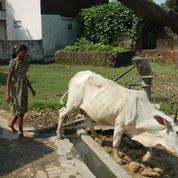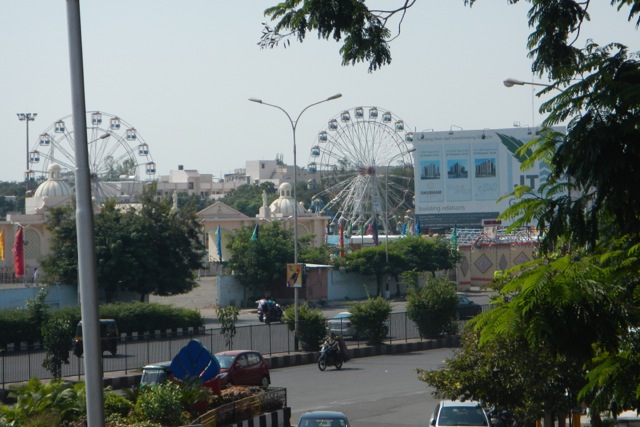
Cross-posted from Legal Planet.
Six months ago, the D.C. Circuit upheld EPA’s finding that greenhouse gases endanger human health and welfare, triggering coverage under the Clean Air Act. On Thursday, the full court denied rehearing to the three-judge panel’s decision. There were only two dissents, which obviously were hoping to set the stage for a cert. petition to the Supreme Court. The dissents provide a preview of the kinds of arguments that will be made to the Supreme Court.
One key point is that neither dissent questioned the scientific basis for EPA’s finding. It is clear that the climate skeptic positions advanced by the state of Texas have no traction even with very conservative judges.
The strongest arguments raised by the dissents involve a technical statutory issue. The case involves provisions of the Clean Air Act that apply to “any air pollutant.” The dissent argues that this means “any criterion air pollutant” (meaning the six pollutants that are most extensively regulated by the statute.” I discussed this issue extensively in a post about the original decision, so I won’t go into the details here, but I think EPA’s position on this issue is sound. It’s notable than only two of the conservatives on the D.C. Circuit were willing to endorse the attack on the EPA’s interpretation.
Full textIn October, I wrote about the city of Surat, the diamond-polishing capital of India, and its battle against climate change. Recently I had the chance to visit another municipality working on adaptation, a place known more for its postage stamp farms and wandering livestock than jewelry and textiles. It’s called Gorakhpur, and is located in the flood-prone state of Uttar Pradesh, near the India-Nepal border.
 I first visited Gorakhpur nearly 25 years ago--when I was a long-haired backpacker and Gorakhpur was a muddy stop on the way to Kathmandu. Some things there haven’t changed. The streets are still muddy. Tea stalls and tarpaulin tents still line the streets, illuminated by the blue flames of cook stoves. At my business hotel, electricity was as unreliable as ever, and the telephones still crackled and hissed. Each morning, I would greet a dozen or so cows grazing on a hillock of garbage outside the hotel gate. (The city still has no regular solid waste collection).
I first visited Gorakhpur nearly 25 years ago--when I was a long-haired backpacker and Gorakhpur was a muddy stop on the way to Kathmandu. Some things there haven’t changed. The streets are still muddy. Tea stalls and tarpaulin tents still line the streets, illuminated by the blue flames of cook stoves. At my business hotel, electricity was as unreliable as ever, and the telephones still crackled and hissed. Each morning, I would greet a dozen or so cows grazing on a hillock of garbage outside the hotel gate. (The city still has no regular solid waste collection).
But Gorakhpur has also changed in important ways. The city has over four hundred thousand people, with millions more in the surrounding district. There are malls, cineplexes, fast-food joints, and pizzerias! What began as a small urban core has spread erratically, encroaching upon lakes, marshes, and scores of farm villages—all held together by a hectic flow of traffic and a mighty, tea-stained dome of hydrocarbons.
Full textCross-posted from Legal Planet.
Mayan apocalypse: panic spreads as December 21 nears
Fears that the end of the world is nigh have spread across the world with only days until the end of the Mayan calendar, with doomsday-mongers predicting a cataclysmic end to the history of Earth.
That’s from a British newspaper, the Telegraph, but you only have to Google “Mayan Calendar” to find lots of similar items. There seems to be no basis at all for the idea that the Mayans thought the world would end at this point, let alone that it actually will. But it’s certainly gotten people excited.
Ironically, people seem to be much less excited about climate change. That’s ironic for two reasons. First, it’s at least conceivable that the climate will hit a tipping point with catastrophic (though probably not apocalyptic) consequences. And second, what destroyed the Mayan civilization wasn’t some supernatural event tied to their calendar. It was probably climate change, according to archaeologists.
As the NY Times reports,
Full textThe early classic Maya period — about A.D. 450 to 660 — “was remarkably wet,” said an author of the study, Douglas Kennett, a geo-archaeologist at Penn State. “There was a proliferation of population, an increase in agriculture and a rise in divine kings that became prominent leaders.”
But then things dried up. The researchers compared the climate record with an existing “war index” — a log of hostile events based on how often certain keywords occurred in Maya inscriptions on stone monuments — and found a strong correlation between drought and warfare between cities.
Action on climate change should be one of the first things President Obama takes on in his second term. There are countless steps the President might take, but perhaps one of the easiest things for him to do on that front is to instruct the Office of Management and Budget (OMB) to release eight Department of Energy (DOE) rules regarding energy efficiency currently under OMB’s review. Regular readers will know that OMB is a kind of regulatory purgatory where rules can be held up seemingly indefinitely or sent back to the agencies responsible for them to be reconsidered in light of OMB’s widely questioned cost benefit analysis. As Earthjustice and others have noted, President Obama could make substantial progress on climate change by telling his own OMB that it needs to move on the rules.
Some of the DOE rules have been at OMB for well over a year, and the benefits of energy efficiency are being foregone while they are held up. DOE’s Fossil Fuel Energy Consumption Reduction for New Construction and Major Renovations of Federal Buildings rule, for instance, has reached the final rule stage but has been stuck at OMB since August of 2011. Beginning one year after it is finalized, the rule would require that new federal buildings and those that undergo major renovations adhere to new limits on their fossil fuel consumption. Five years after that, stricter limits would go into effect for further renovations or constructions. So, the sooner OMB releases the rule the sooner the rule will take effect and we can start realizing its significant benefits.
DOE estimated the rule will bring significant emissions reductions: in the first year after the rule takes effect it will prevent 52,700 metric tons of carbon dioxide, 111 metric tons of methane, 53 metric tons of nitrogen, and 151 metric tons of sulfur dioxide from entering the atmosphere. These reductions will increase rapidly as other buildings are renovated and the standards are tightened at five-year intervals.
Full textFor those who have not been following the news lately, a recent article reported the following: A large tropical storm attributed to “unseasonable rainfall” slammed into the coast and moved inland, leaving many dead or missing, tens of thousands of residents evacuated or homeless, and government disaster response agencies struggling to provide food, shelter, and other critical services.
According to the article, “[d]isaster response teams helped to move people to higher ground in rubber boats and nearly 100 shelters were opened … to accommodate people fleeing the flood zone.” Trains and other transit systems were closed; some communities were completely cut off from help; and to make matters worse, more intense rain was expected later in the same week.
News reports about Hurricane Sandy? Actually, no. This news came from an article by Agence France-Presse about Cyclone Nilam, which struck the Indian states of Andhra Pradesh and Tamil Nadu just a week after Sandy unleashed similar catastrophe on the eastern United States. Nor was this an isolated incident in India. In September, the Agence France-Presse article continued, “two million people were forced to flee their homes in the north-eastern state of Assam after floods triggered by heavy monsoon rains.”
The point, of course, is not to minimize the horrible loss of lives, damage to homes and other property, and suffering that the residents of the northeastern U.S. have endured due to Hurricane Sandy. Relief efforts should continue if not expand. Public disaster relief funding should be expedited. Private parties should donate to the Red Cross and other independent sources of relief.
Full text Last weekend my son took part in a set of Boy Scout activities with his local Delhi scout troop. On the grounds of the former residence of the U.S. ambassador, the boys prepared a kabob lunch, practiced fire making, and even built a Medieval-style trebuchet. But all I could think about were the little striped mosquitoes that seemed to follow the kids everywhere—Asian Tiger mosquitoes, to be exact, the kind that carry dengue fever.
Last weekend my son took part in a set of Boy Scout activities with his local Delhi scout troop. On the grounds of the former residence of the U.S. ambassador, the boys prepared a kabob lunch, practiced fire making, and even built a Medieval-style trebuchet. But all I could think about were the little striped mosquitoes that seemed to follow the kids everywhere—Asian Tiger mosquitoes, to be exact, the kind that carry dengue fever.
In New Delhi, dengue (DEN-gay) has reached epidemic proportions. The scouts, I’m happy to say, completed their tour without infection, thanks to lots of lotion, spray, and smoky coils. But not everyone has been so lucky. I know at least five people who have been confined to bed for two weeks of fever, headaches, and joint pain. (My medical traveler’s guide says it feels as if “knitting needles have been driven into every joint of [your] body.”) The New York Times reported last week that Delhi hospitals “are overrun and feverish patients are sharing beds and languishing in hallways.” The illness, which in extreme forms can require blood transfusions and even kill, is breaking out all over the country. Official reports say that this year 30,002 people in Indian have fallen ill with dengue through October. But experts believe the real number is around 37 million.
Full textCross-posted from Environmental Law Prof Blog.
Unlike climate change, clean energy policy has received a fair bit of attention in the presidential campaign. Obama made clear that he supports renewable energy as part of his "all of the above" approach, while Romney would end an important federal subsidy for wind power and otherwise increase reliance on coal, oil and gas. But for those who are disappointed that Obama didn’t say more about our need to transition away from fossil fuel and towards renewables, remember the old adages “actions speak louder than words” and “put your money where your mouth is.” Here are some facts about Obama’s actions and expenditures:
First, we must recall that subsidies for fossil fuels have been a fixture in US energy policy. As discussed in a recent report by venture capital firm DBL Investors, these subsidies have come in many forms including direct payments and preferential loans; favorable tax treatment; and government investment in R&D and infrastructure. Coal mining companies have enjoyed generous tax treatment since the early 1930s, and the government’s investment in geological surveys and railroads also greatly facilitated coal-fired electricity. Natural gas combustion technology benefited from billions of dollars worth of jet engine technology research funded by the Department of Defense research. The report finds that, in total, the oil and gas industries received about $350 billion in subsidies between 1918 and 2009.
Full textThe most solemn commitment borne by an elected official is to promote the public welfare and keep the citizenry safe. As New York City struggles to rebound from one of the fiercest storms in memory, Mayor Michael R. Bloomberg rose to that occasion with an urgent call for government at all levels to forcefully address climate change.
Yes, folks, Gotham gets it.
In an editorial for Bloomberg View, the mayor wrote:
The devastation that Hurricane Sandy brought to New York City and much of the Northeast -- in lost lives, lost homes and lost business -- brought the stakes of Tuesday’s presidential election into sharp relief.
The floods and fires that swept through our city left a path of destruction that will require years of recovery and rebuilding work. . . . In just 14 months, two hurricanes have forced us to evacuate neighborhoods -- something our city government had never done before. If this is a trend, it is simply not sustainable.
Our climate is changing. And while the increase in extreme weather we have experienced in New York City and around the world may or may not be the result of it, the risk that it might be -- given this week’s devastation -- should compel all elected leaders to take immediate action.
He described New York City’s own efforts to fight climate change by reducing carbon emissions “by 16 percent in just five years.” He could also have noted his city’s impressive planning efforts to adapt to those climate effects that can no longer be avoided.
Full text If you like sparkling diamonds and saffron saris, you will love Surat, India’s bustling, no-nonsense city, some 250 kilometers north of Mumbai, near the Arabian Sea. If you’re wearing a new diamond, there’s an 80% chance its was shaped by Surati hands (and laser beams too). And nearly every Indian has something in the closet from Surat—which is what you’d expect from a city whose clattering looms churn out 30 million meters of raw fabric a day.
If you like sparkling diamonds and saffron saris, you will love Surat, India’s bustling, no-nonsense city, some 250 kilometers north of Mumbai, near the Arabian Sea. If you’re wearing a new diamond, there’s an 80% chance its was shaped by Surati hands (and laser beams too). And nearly every Indian has something in the closet from Surat—which is what you’d expect from a city whose clattering looms churn out 30 million meters of raw fabric a day.
But Surat, with a population of 4.5 million, faces big challenges too. Its proximity to the Tapti River delta—a strategic advantage in trade—also makes Surat a flood magnet. In the last 20 years, the city has been drowned by three major floods caused by emergency releases from an upstream dam. Lesser floods, caused by hard rains, occur more frequently, interrupting local business and displacing families living in flood plains. In 1994, a flood like that led to an outbreak of the plague. In addition, tidal surges moving up the mouth of the Tapti River threaten the city from the oppositedirection. Even on calm days, high tides push salt water into parts of the river needed for drinking. All of these problems will be made considerably worse by climate change, whose effects include stronger downpours and rising seas.
Full textVARANASI -- We slip into the river at night, and with an easy stroke, our oarsman moves our boat across the chestnut waters of “Mother Ganga,” India’s Ganges River.
Spiritual life in Varanasi (also called Benares) is a passion. Hindus all over India save their money for the chance to visit this holy city and bathe in Ganga’s purifying waters. At sunrise, along the string of bathing steps called “ghats,” you’ll see hundreds of people of all shapes and sizes soaping up in the water, praying, laughing and chatting, or just bobbing along. At the so-called “burning ghats,” open-air cremations take place twenty-four hours a day in quiet ceremonies attended by family and curious onlookers. But this evening, my family and another, visiting from Maharashtra, are on our way to watch the Ganga Aarti, a Hindu ceremony of music and prayer devoted to Mother Ganga. The ceremony is ancient. But it takes on new power when you consider that today the Ganges is all but an environmental disaster—a septic river, riddled with industrial poisons and now threatened by climate change. If Mother Ganga were human, she would be in the I.C.U.
Full text